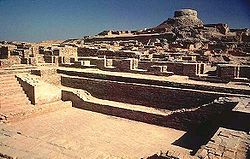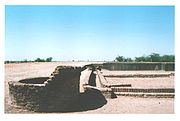
Sanitation of the Indus Valley Civilization
Encyclopedia



Indus Valley Civilization
The Indus Valley Civilization was a Bronze Age civilization that was located in the northwestern region of the Indian subcontinent, consisting of what is now mainly modern-day Pakistan and northwest India...
of Pakistan
Pakistan
Pakistan , officially the Islamic Republic of Pakistan is a sovereign state in South Asia. It has a coastline along the Arabian Sea and the Gulf of Oman in the south and is bordered by Afghanistan and Iran in the west, India in the east and China in the far northeast. In the north, Tajikistan...
and modern-day northwest India was prominent in hydraulic engineering
Hydraulic engineering
This article is about civil engineering. For the mechanical engineering discipline see Hydraulic machineryHydraulic engineering as a sub-discipline of civil engineering is concerned with the flow and conveyance of fluids, principally water and sewage. One feature of these systems is the extensive...
, and had many water supply
Water supply
Water supply is the provision of water by public utilities, commercial organisations, community endeavours or by individuals, usually via a system of pumps and pipes...
and sanitation
Sanitation
Sanitation is the hygienic means of promoting health through prevention of human contact with the hazards of wastes. Hazards can be either physical, microbiological, biological or chemical agents of disease. Wastes that can cause health problems are human and animal feces, solid wastes, domestic...
devices that were the first of their kind.
Among other things, they contain the world's earliest known system of flush toilet
Flush toilet
A flush toilet is a toilet that disposes of human waste by using water to flush it through a drainpipe to another location. Flushing mechanisms are found more often on western toilets , but many squat toilets also are made for automated flushing...
s. These existed in many homes, and were connected to a common sewerage pipe. Most houses also had a private water well
Water well
A water well is an excavation or structure created in the ground by digging, driving, boring or drilling to access groundwater in underground aquifers. The well water is drawn by an electric submersible pump, a trash pump, a vertical turbine pump, a handpump or a mechanical pump...
. City walls functioned as a barrier against flood
Flood
A flood is an overflow of an expanse of water that submerges land. The EU Floods directive defines a flood as a temporary covering by water of land not normally covered by water...
s.
Lothal
Lothal
Lothal is one of the most prominent cities of the ancient Indus valley civilization. Located in Bhāl region of the modern state of Gujarāt and dating from 2400 BCE. Discovered in 1954, Lothal was excavated from February 13, 1955 to May 19, 1960 by the Archaeological Survey of India...
was a port at the Indian Ocean
Indian Ocean
The Indian Ocean is the third largest of the world's oceanic divisions, covering approximately 20% of the water on the Earth's surface. It is bounded on the north by the Indian Subcontinent and Arabian Peninsula ; on the west by eastern Africa; on the east by Indochina, the Sunda Islands, and...
with a dockyard.
Mohenjo-daro
Mohenjo-daroMohenjo-daro
Mohenjo-daro is an archeological site situated in what is now the province of Sindh, Pakistan. Built around 2600 BC, it was one of the largest settlements of the ancient Indus Valley Civilization, and one of the world's earliest major urban settlements, existing at the same time as the...
is one of the best preserved settlements from this civilization. The Great Bath
Great Bath, Mohenjo-daro
The Great Bath is one of the best known structures among the ruins of the ancient Indus Valley Civilization at Mohenjo-daro in Sindh, Pakistan. It is located in the well-preserved northern part of Mohenjo-daro's western mound, which is also known as the "Mound of the Great Bath" or the...
contains a swimming pool
Swimming pool
A swimming pool, swimming bath, wading pool, or simply a pool, is a container filled with water intended for swimming or water-based recreation. There are many standard sizes; the largest is the Olympic-size swimming pool...
which might be the first of its kind.
See also
- HarappaHarappaHarappa is an archaeological site in Punjab, northeast Pakistan, about west of Sahiwal. The site takes its name from a modern village located near the former course of the Ravi River. The current village of Harappa is from the ancient site. Although modern Harappa has a train station left from...
- Harappan architectureHarappan architectureHarappan architecture is the architecture of the Harappans, an ancient people who lived in the Indus Valley from about 3300 BCE to 1600 BCE. The Harappans were advanced for their time, especially in architecture.- City walls :...
- History of water supply and sanitationHistory of water supply and sanitationThis article covers the history of water supply, plumbing, sanitation and sewage collection and disposal.-Ancient age:During the Neolithic, man dug the first permanent water wells, from where vessels could be filled and carried by hand. The size of human settlements was largely dependent on nearly...
- Sanitation in Ancient RomeSanitation in Ancient RomeSanitation in ancient Rome was a complex system similar in many ways to modern sanitation systems. During the Dark Ages, the technical knowledge of the system was lost and has subsequently been investigated by modern-era historians and archeologists....

